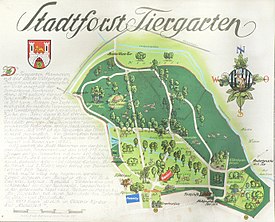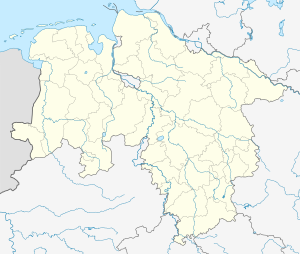Tiergarten (Hanover)
| Tiergarten (Hanover) | ||
|---|---|---|
| Full name | Hanover Zoo | |
| place | Tiergartenstrasse 149 30559 Hanover |
|
| surface | 112 ha | |
| opening | 1678/79 | |
| organization | ||
|
Sign zoo Hanover |
||
| Description at hannover.de | ||
|
|
||
Coordinates: 52 ° 21 ′ 58 ″ N , 9 ° 50 ′ 9 ″ E
The zoo Hannover is a 112 ha large park with forest area in the district Kirchrode in southeastern Hannover . In the fenced-in area, visitors can move on paths between free-roaming wild animals . The zoo is one of the oldest game reserves in Germany and was gated as a stately hunting area at the end of the 17th century . Since it became accessible to the population from 1799, it has been a popular destination for recreation and excursions for the Hanover city population.
location
The zoo is located in the north of the Kirchrode district. It is located east of the Hermann-Löns-Park , from which it is separated by the freight bypass . The Hanover – Lehrte railway line runs north of the zoo, and in the east it is separated from the Anderten district by the Landwehrgraben . The zoo can be reached with the tram line 5 .
Wildlife
A large herd of fallow deer can roam freely in the mostly wooded area, red deer and wild boar live in spacious enclosures. The park has space for 120–150 fallow deer , some roe deer and red deer and, depending on the season, 5–30 wild boars . The red deer came in 1997 to replace the wild horses . In November and December game is shot in the mornings and its meat is sold in Hanover.
In addition, smaller mammals such as foxes , badgers , stone marten , squirrels and hares live in the park . The zoo is also home to around 12 species of bats that find shelter in hollowed-out trees. The year-round bird species also includes several species of woodpecker , hawks , kestrels , long- eared owls and common ravens . Summer guests are cuckoos , tree falcons , Egyptian geese and nightingales , while rooks , mountain finches and crested larks can be found in winter . Since clearing is largely avoided, many trees are already several hundred years old.
Sights, offers and rules
About half of the park area consists of meadow with individual trees, the other half of high forest . The old forest with 400 to 500 year old oaks is worth seeing. Near the main entrance is the 1000 year old oak tree , but it is estimated to be around 650 years old. This 25 m high tree was struck by lightning in the mid-1970s and badly damaged. In 1983 it had to be renovated because it threatened to break.
Up to 30,000 visitors relax in the park on weekends. Several times a year there are excursions in the park. Since 1977, the zoo has been held every year on the 2nd Saturday in October as a children's festival, in which up to 20,000 guests take part. With this, the city of Hanover, as the operator of the garden, thanks for the collection of acorns and chestnuts . Children collect around 20 tons annually for winter feeding of the animals.
In the park, a memorial stone commemorates a hunt in 1858, when the 13-year-old Crown Prince Ernst August shot his first fallow deer.
A half-timbered barn built in 1751 stands in a forest clearing . The feed barn was initially used to store acorns and chestnuts, and today it is used for hay. At the barn is the inaccessible feeding place with cribs .
The following rules of conduct apply to visitors in the zoo:
- No game feeding
- Do not leave the path
- No dogs
- No Bicycles
- No inline skating
- Antlers are not allowed
- No collecting of chestnuts and acorns
history
The establishment of the zoo goes back to Duke Johann Friedrich . In 1678/79 he had the so-called Sundern , an oak and beech forest, fenced in to use it as a hunting ground. The game brought in was used for hunting and enriched the meat room of the ruling house. The size at that time was around 380 Hanover acres (106 ha). A feed barn was built in 1751 and has been preserved to this day. Magnificent court hunts were held in the zoo, in later times they were state hunts. In 1799 the hunting area was opened by King George III. Made accessible to the population and quickly developed into a popular excursion destination. In 1800 a gamekeeper house was built with a restaurant attached later. After Hanover was occupied by Prussian troops in 1866, the Prussian forest administration was responsible for the garden. In 1903 the facility with 400 fallow deer was bought by the city of Hanover for 520,000 Reichsmarks . In 1904/05 the zoo received an inn designed by Paul Rowald .
Towards the end of the Second World War in 1945, the zoo lost all of its wildlife and remained empty until 1948. Because of the war-related famine, the animals ended up in the cooking pots of the Hanoverian population. At the beginning of the 1960s the restaurant was demolished and replaced by a new building, which has been expanded several times until today.
Hermann Löns , namesake of the neighboring Hermann Löns Park , was a journalist in Hanover at the beginning of the 20th century. He immortalized the zoo in 1907 in the form of a school essay by Aadje Ziesenis.
literature
- Wolfgang Neß : Tiergarten. In: Monument topography Federal Republic of Germany , architectural monuments in Lower Saxony, city of Hanover. (DTBD), Part 2, Volume 10.2, ed. by Hans-Herbert Möller , Lower Saxony State Administration Office - Institute for Monument Preservation , Friedr. Vieweg & Sohn Verlagsgesellschaft, Braunschweig 1985, ISBN 3-528-06208-8 , p. 93; as well as Kirchrode in the addendum : List of architectural monuments acc. § 4 ( NDSchG ) (excluding architectural monuments of the archaeological monument preservation), status: July 1, 1985, City of Hanover Lower Saxony State Administration Office - publications by the Institute for Monument Preservation , p. 19.
- Franz Rudolf Zankl: School festival in the zoo. Oil painting by Rudolf Weber. 1903. In: Franz Rudolf Zankl (Ed.): Hannover Archive . Sheet B 69
- Helmut Knocke , Hugo Thielen : Tiergarten. In: Dirk Böttcher , Klaus Mlynek (Ed.): Hannover. Art and culture lexicon . (HKuKL), new edition, 4th, updated and expanded edition. zu Klampen, Springe 2007, ISBN 978-3-934920-53-8 , p. 205.
- Kaspar Klaffke , Gesa Klaffke-Lobsien : Hanover - City of Gardens. Gardens of a city. 1st edition. Kallmeyer, Seelze-Velber 2000, ISBN 3-7800-5265-2 , pp. 36-40.
- Silke Beck, Klaus Helmer (ed.), Dirk Altwig, Gerd Garnatz (text): The zoo. Ed .: City of Hanover, the Lord Mayor, Department of Environment and Urban Greenery, Department of Forests, Landscapes and Nature Conservation. LHH, Hanover 2005.
- Karina Kolesnik (ed.), Liudmila Gurevich (text), Dimitrij Czepurnyi (photos, watercolors): Hanover park landscapes. (= Parks of Hannover ). (= Садьі и пaрҝи Ганновер ). Texts in German, English and Russian. Tolstoy-Aid and Cultural Work, Hannover 2009, ISBN 978-3-00-029766-3 .
- Günter Gebhardt: Military affairs, economy and traffic in the middle of the Electorate and Kingdom of Hanover 1692–1866 . (= Studies on the history of Lower Saxony. Volume 1). ibidem (Edition Noëma), Stuttgart 2010, ISBN 978-3-8382-0184-9 .



